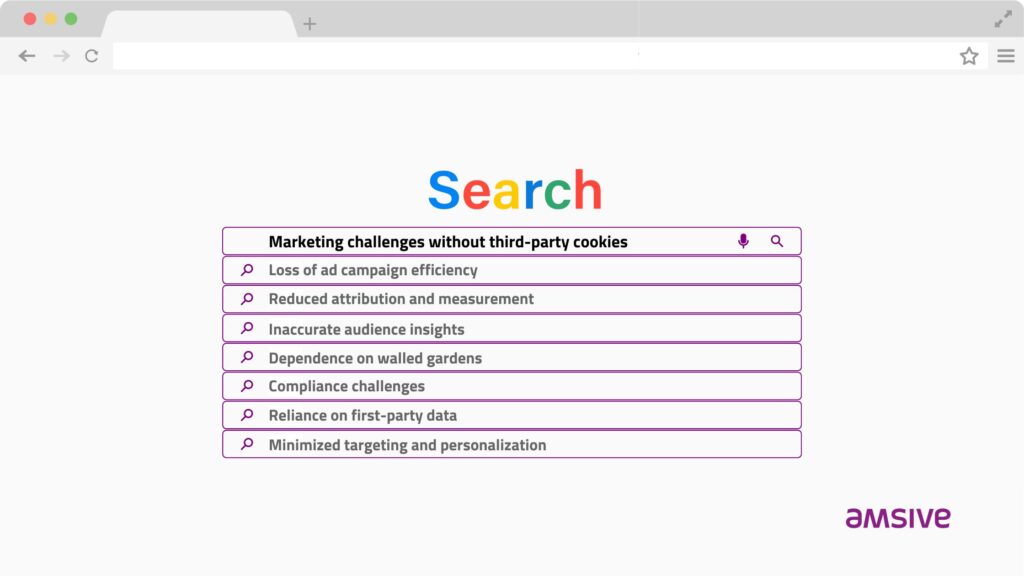Google’s plans for third-party cookie deprecation started off strong in January 2024. Their first step toward enacting this plan occurred on January 16 of this year, when 1% of third-party cookies were deprecated—affecting roughly 30 million globally. While this change initially came with the warning that Google planned on deprecating third-party cookies by Q3 of 2024, this target may face further delays. This comes from the UK’s Competition and Markets Authority (CMA), which has raised about Google potentially gaining an unfair competitive advantage.
Google has made efforts to actively address the CMA’s competitor concerns and is confident that the third-party cookie deprecation will be on track for the second half of 2024.
Jump To:
Why does Google want to get rid of third-party cookies?
In a digital landscape increasingly mired with data breaches and consumer privacy concerns, third-party cookies can indiscriminately collect consumer’s data from their IP addresses. This information can include “health, sexuality, family, political convictions, religious beliefs, and much more.” Having so much data could negatively overstep the boundaries of a company’s data privacy policies.
What is Google replacing third-party cookies with?
The tech giant first announced its Privacy Sandbox initiative in 2019, and its plans to limit third-party cookies in January 2020. According to Google’s documentation, their Privacy Sandbox program “aims to create technologies that both protect people’s privacy online and give companies and developers tools to build thriving digital businesses.”

Google’s Tracking Protection limits the use of cross-site tracking abilities by automatically deprecating third-party cookies. The path to deprecating cookies had been neither straight nor smooth, with Google taking the time to ensure that its Privacy Sandbox Solution was thoroughly tested and incorporated marketers’ feedback.
How will cookie deprecation challenge marketers?
Marketers have relied on these cookies to track user behavior, personalize ads, measure campaign performance, and gain valuable insights into audience preferences across sites and devices. However, increasing concerns about user privacy and regulatory changes have led to phasing out support for third-party cookies. This shift will have far-reaching implications for the marketing landscape, leading marketers to rethink their strategies, technologies, and operations. There are several factors that marketers need to weigh when adjusting their strategies, including:
Loss of ad campaign efficiency
Without access to this user behavior, demographic, and interest data, marketers may struggle to identify and reach their target audiences effectively. This could lead to lower click-through rates, higher acquisition costs, and diminished campaign performance overall.
Reduced attribution and measurement
Without third-party cookies, marketers have trouble accurately tracking campaign performance and attributing conversions to specific channels or ads. This could lead to discrepancies in reporting and make it challenging to gauge ROI and optimize marketing spend effectively.
Inaccurate audience insights
Third-party cookies help marketers segment audiences, personalize messaging, and deliver relevant content across channels. With the demise of third-party cookies, marketers may lose access to these insights, potentially jeopardizing their understanding of audience behavior. This could lead to ineffective targeting and reduced engagement across campaigns.
Dependence on walled gardens
As third-party cookies are deprecated, marketers will likely rely more on walled garden platforms such as Google, Facebook, and Amazon, which have vast amounts of first-party data. However, this dependency on walled gardens could limit choice and innovation in the digital ecosystem, with smaller companies struggling to compete with the data and resources of large tech companies. It could also increase costs for advertisers as competition for ad inventory on these platforms intensifies.
Compliance challenges
The deprecation of third-party cookies will present significant compliance challenges for marketers, considering evolving privacy concerns and increased regulations. These regulations enact strict guidelines around the collection and use of consumer data, including consent, transparency, and rights.
Reliance on first-party data
Marketers will need to shift their focus towards leveraging first-party data that can be gleaned directly from their customers. First-party data can include information collected from website visits, email interactions, and other owned channels, providing marketers with valuable insights into customer behavior and preferences.
Minimized targeting and personalization
With the loss of third-party cookies, marketers face a challenge in targeting and personalization—a tricky reality in a landscape where consumers increasingly value personalization in marketing. Without access to granular user data, marketers will need to find new ways to reach the right audiences on the right platform with the right messaging at the right time. This could lead to decreased ad relevance, lower engagement rates, and reduced ROI on advertising spend.

What can marketers do?
Marketers have to rethink targeting and ensure that they remain compliant with evolving privacy laws. Whether you’re well-prepared or just beginning to strategize for cookie deprecation, these tips can help you stay ahead of the curve.
1. Take inventory of what you know for sure
Start by auditing your existing data infrastructure, analytics tools, and tracking mechanisms. Identify all the data sources you currently rely on, whether it’s first-party, second-party, third-party, or a combination. This inventory will give you a clear picture of your data landscape and help you strategize effectively for the future. Understanding your current data ecosystem thoroughly will allow you to make informed decisions as you navigate the changes brought about by third-party cookie deprecation.
2. Get in the Privacy Sandbox
Familiarize yourself with initiatives like Google’s Privacy Sandbox. These privacy initiatives propose alternative solutions for targeted advertising without relying on individual user tracking. By understanding and participating in these developments, you can stay ahead of the curve and adapt your marketing strategies accordingly. The Privacy Sandbox offers insights into the direction of privacy-focused technologies, providing valuable guidance for your advertising approach post-cookie deprecation.
3. Resolve customer data inaccuracies early
Prioritize data accuracy by addressing any discrepancies or inconsistencies in your customer data. Clean and reliable data is the foundation of effective marketing strategies, especially in a cookie-free environment. By resolving data inaccuracies proactively, your targeting efforts will be based on precise information, leading to better outcomes and improved customer experiences. Take the time to clean up your data sources, validate information, and establish robust data management practices to support your marketing efforts moving forward.
4. Hone in on accurate customer data
First-party data offers a more precise and trustworthy source of information about your audience. This data includes insights gathered from interactions with your website, app, or other owned channels. By leveraging first-party data, you can continue to deliver personalized experiences, targeted messaging, and relevant offers to your customers. Make sure to optimize your data collection processes and invest in strategies for maximizing the value of your first-party data assets.
5. Build a first-party data strategy
First-party data can fuel personalized experiences, targeted messaging, and effective campaign optimization. Establish processes for gathering first-party data across touchpoints, including your site, mobile app, email, and offline interactions. Encourage users to sign up for newsletters, create accounts, or participate in surveys. This data is more reliable and privacy-friendly. Make your data collection and usage policies clear when you communicate with users, and make sure you have their consent to track their data and personalize their experiences based on their preferences. By building a robust first-party data strategy, you can future-proof your marketing efforts and reduce reliance on third-party cookies, while also deepening your understanding of your audience and improving overall engagement and loyalty.
6. Utilize contextual + behavioral targeting
Shift your targeting strategies away from individual user tracking, and toward contextual and behavioral approaches. Contextual targeting involves analyzing the content context in which ads are displayed, ensuring alignment between ad placement and the surrounding content. Behavioral targeting focuses on understanding user behavior and interests based on online activities, without needing personally identifiable information. By combining these targeting types, you can more effectively reach your target audience with relevant messaging while respecting their privacy preferences.
7. Lean into intent data
Capture and analyze intent signals to understand the needs and preferences of your audience. Intent data offers valuable insights into the intentions and interests of users, helping you tailor your marketing messages and offers accordingly. Leveraging intent data enables you to reach high-intent consumer prospects, anticipate their needs, and deliver personalized experiences for increased engagement and conversions. Look for opportunities to gather intent signals from different touchpoints along the customer journey, including search queries, interactions, and social media engagement.
8. Consider offline conversion tracking
Explore alternative methods for tracking conversions and attributing them to your digital marketing efforts, especially in cases where online interactions lead to offline transactions. Offline conversion tracking helps marketers bridge the gap between online engagement and real-world outcomes, offering valuable insights into campaign effectiveness. Track for real-life solutions, including mailers featuring unique promo codes or in-store attribution models to capture offline conversions accurately. By measuring the impact of your digital marketing activities on offline behavior, you can optimize your strategies for driving both online and offline results and increase the return on your marketing investment.
9. Explore data clean rooms
Data clean rooms provide a controlled environment where multiple parties can share and analyze data without exposing sensitive information or violating privacy regulations. By leveraging data clean rooms, you can collaborate with trusted partners, combine datasets, and gain valuable insights while maintaining privacy compliance. Look into platforms and services with data clean room capabilities to guarantee that your data collaboration efforts are secure, transparent, and privacy-centric.
10. Utilize AI with helpful prompts
AI can analyze mountains of data, allowing marketers to easily identify patterns, and generate targeting strategies around these insights. By leveraging AI prompts, you can streamline decision-making processes, optimize campaign performance, and deliver increasingly relevant experiences to your audience.
11. Investigate second-party relationships (that are highly regarded)
Second-party relationships involve sharing data directly with a trusted partner, enabling you to access additional audience insights and expand your targeting capabilities. Identify partners with complementary offerings, shared values, and a strong reputation for data privacy and security. To ensure that these partnerships are compliant, create transparent agreements and protocols for data sharing to ensure mutual trust and compliance with regulations. By leveraging second-party relationships, you can enrich your audience insights, enhance targeting precision, and unlock new opportunities for growth and innovation in your marketing efforts.
12. Dig into your Google Analytics
Review and optimize your analytics setup, especially if you rely on platforms like Google Analytics for tracking and measuring website performance. Make sure that your analytics configurations are compliant with privacy regulations and aligned with changes in data tracking methodologies. Take advantage of features and tools offered by your analytics platform to gain deeper insights into user behavior, engagement metrics, and conversion pathways. Customize reports, set up goals and events, and leverage advanced analytics features to track and measure the effectiveness of your marketing campaigns accurately. By analyzing your data effectively, you can identify trends and optimize performance to drive growth and success.
13. Amplify your audience solutions
Consider a new audience solution, whether it’s cohort-based, seller-defined audiences, or a universal ID solution.
Cohort-based solutions allow you to define audience groups on a shared factor, such as behaviors, demographics, or interests. This helps you craft highly personalized communication.
Seller-defined audiences lean heavily on a wealth of proprietary first-party data. This data allows for a highly targeted and niche audience solution, balancing personalization, and privacy.
Universal ID solutions assign a single identifier to each user, creating a data-compliant identity that tracks the consumer across touchpoints.
While each of these options present their own set of pros and cons, their implementation will allow for great audience definition while remaining compliant with evolving privacy laws and policies.
How is Amsive approaching third-party cookie deprecation?
While other agencies may be restrategizing for cookie deprecation, Amsive is ahead of the curve because, through our data capabilities and expertise, we don’t rely on them.
Third-party cookie tracking has been a simple solution to serving targeted ads, but it’s always been mired with flaws beyond privacy concerns, which have historically resulted in performance challenges. Amsive saw this years ago and got ahead of the game by building better approaches, leaning into the use of matchback automation, marketing mix models, and lifetime value models to deliver more accurate, personalized content in a compliant way. That investment in better solutions (and the ability to do so successfully) has improved value and elevated ROI for our clients.
Consider Your Marketing Priorities
Google remains determined to implement third-party cookie deprecation by the latter half of 2024, albeit with additional consideration of competition concerns raised by regulators. Additionally, marketers face challenges in navigating the evolving regulatory landscape when retooling their data collection efforts. By prioritizing compliance and data ethics, marketers can foster consumer loyalty and trust.
By embracing change, harnessing emerging technologies, and prioritizing consumer privacy and trust, marketers will emerge stronger, more agile, and better positioned in a privacy-centric digital future. With strategic foresight and collaborative partnerships, marketers can confidently navigate this critical moment and become leaders in the new marketing age.
Not every solution listed will work for every marketer, and that’s why it’s important to continually reassess and monitor your campaign performance. If contextual targeting doesn’t work, try behavioral. If behavioral doesn’t work, try intent. It may take some trial and error, but you’ll hit on the right strategies for your organization and customers.
Learn how to revolutionize your marketing strategy in 2024, or, let’s talk about how to achieve more for your marketing—and your business.






